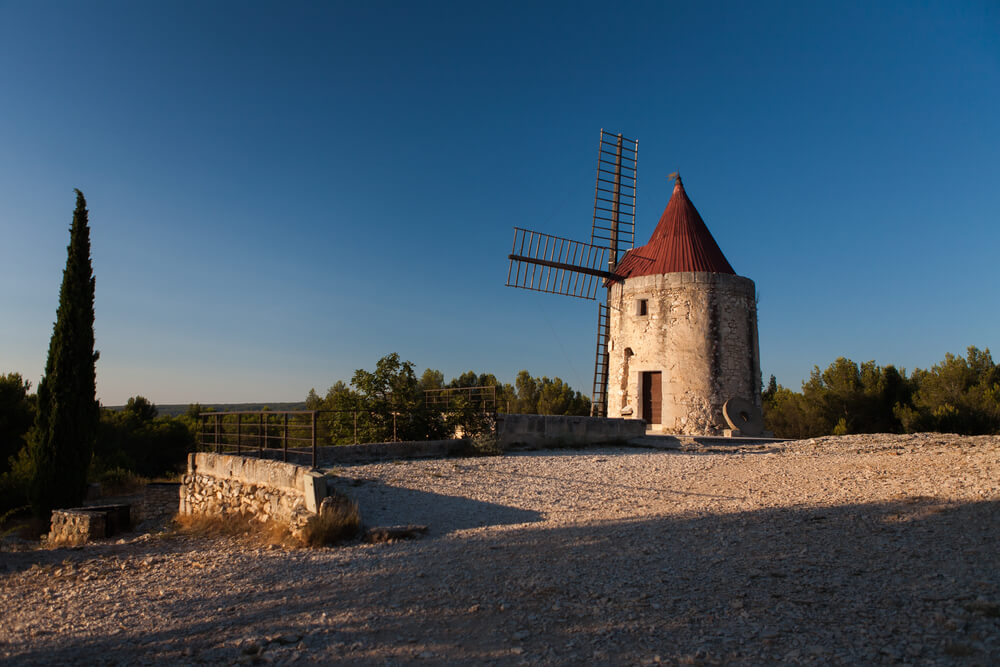Visit Alphonse Daudet’s mill in Fontvieille

Alphonse Daudet’s mill is located in Fontvieille, near Arles in the Bouches-du-Rhône department, firmly rooted on its small hill. Although the author did not write Les lettres de mon moulin here, contrary to legend, it was certainly a real source of inspiration for Alphonse Daudet. Open to visitors, this legendary site is perfect for families, lovers and friends alike.
A brief history of Alphonse Daudet’s mill in Fontvieille
This mill, built in 1814, was used to grind wheat for 100 years until the First World War, when the workers and the wheat were requisitioned. This was not just the end of one mill among many, but the end of the very last mill still in operation in Fontvieille.
It wasn’t until 1935 that an association, the “Friends of Alphonse Daudet”, got together to restore the mill and, at the same time, create a museum dedicated to the writer.
Les lettres de mon moulin refers to the Château de Montauban, a superb eighteenth-century building surrounded by 8 hectares of parkland, also in Fontvieille. Like the mill, the château was a place where the writer found peace and serenity. From the château, you can walk to Alphonse Daudet’s mill in less than 1 hour, just one kilometre away. A signposted family trail from which you can see 3 other mills: the Sourdon mill, the Ramet mill and the Tissot-Avon mill.
The real name of Alphonse Daudet’s mill is the Moulin Ribet, but it was also known as the Moulin Saint-Pierre.
Following its closure in 2000 by the town council, it was renovated in 2016 and reopened to the public.
Did Alphonse Daudet live in Fontvieille?
Alphonse Daudet never lived at the mill, but he did live at the Château de Montauban in Fontvieille, and although he didn’t write Letters from my Windmill in Fontvieille, it was this famous mill that inspired “The Secret of Maître Cornille”. Originally from Nîmes, Alphonse Daudet lived in Paris until he met Frédéric Mistral, whose lilting accent reminded him of the good old country. At the invitation of his cousin Louis Daudet, he went to the Château de Montauban in Fontvieille. There, he met a wide range of people who inspired some of his characters, such as Mitifiot, the country warden, Audiberte, the maid, and Quenin, nicknamed “Lou Roudeirou”.
Fontvieille and the Château de Montauban soon became Alphonse Daudet’s favourite holiday destinations whenever he left the capital. He had a special affection for Provence. After all, as he wrote in Les lettres de mon moulin, “All this beautiful Provençal landscape lives only for the light”.
Alphonse Daudet’s mill and its surroundings
Suspended on a hillside in the middle of the garrigue, it can be seen from afar. Its wings tower over the oak trees and surrounding flora. This mill is not just a museum, it’s also a real testimony to the history of the Alpilles and the trades that were practised here in the past. Along the path leading to the mill, you’ll find a number of signposts offering visitors a wealth of explanations.
Other mills near Alphonse Daudet’s mill
1 – The Sourdon mill
Built in 1791, it operated between the 18th and 19th centuries. This is the oldest of the 4 mills in Fontvieille. It is also known as “the fallen mill”, as it was the first to lose its capital and wings. It was restored in 2015 and is located to the west of the allée des pins.
2 – The Ramet mill
Situated above the village, this mill was built in the early 19th century and operated until the very early 20th century. All that remains today is its barrel. No more capitals or wings.
3 – The Tissot-Avon mill
Close to the Château de Montauban, this mill was the place where Alphonse Daudet liked to reflect. After a century of loyal service, the mill ceased to operate in 1905 following the death of its last miller, Trophime Avon. It was restored in 2016.
Why the Daudet mill?
As we have just seen, the Tissot-Avon mill was Alphonse Daudet’s favourite mill, but when the Société des Amis d’Alphonse Daudet took charge of the renovation work, it chose the Ribet mill because it was much better preserved than the others.
When and how were the letters from my mill published?
Initially, they were published as serials called “Chroniques provençales” in the newspaper L’événement in the summer of 1866, before being published as a collection of 19 letters in the original version, then 24 letters in 1879. These letters deal with Provençal legends and folklore.
What did Alphonse Daudet have to say about the mill?
“In any case, I owe a lot to these spiritual retreats; and none was more beneficial to me than this old mill in Provence. For a while I even wanted to buy it, but my mill never belonged to me. But that didn’t stop me from spending long days there dreaming and reminiscing, right up to the hour when the winter sun descended between the small, flat hills, filling their hollows as if with molten metal, a steaming flow of gold”.
How can I visit Alphonse Daudet’s mill in Fontvieille, opening times and prices?
Alphonse Daudet’s mill in Fontvieille is open every day from 1am to 6pm in April, May, June, September, October and November, and from 10.30am to 7pm in July and August.
Admission costs €2.
What can you see at Alphonse Daudet’s mill in Fontvieille?
As you enter the mill, you’ll see the period mechanism and its lower room. This is also where you’ll find the museum dedicated to the writer and to Lettres de mon moulin. In the shop, you can pick up a little souvenir to remind you of your visit to Alphonse Daudet’s mill in Fontvieille.
200 audioguided tours for cities all around the world
Download


